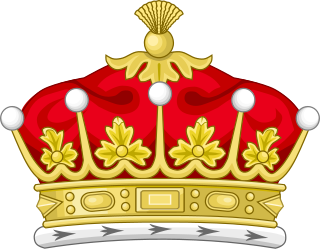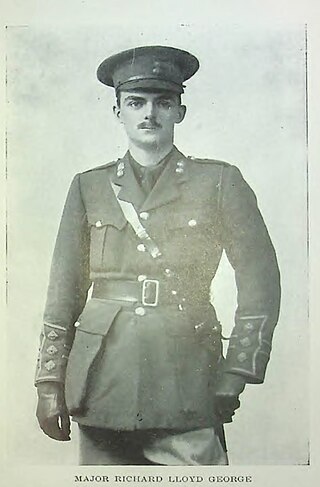Lloyd George commonly refers to David Lloyd George (1863–1945), Prime Minister of the United Kingdom.
Lloyd George may also refer to:
George Gordon may refer to:
The Peerage of the United Kingdom is one of the five Peerages in the United Kingdom. It comprises most peerages created in the United Kingdom of Great Britain and Ireland after the Acts of Union in 1801, when it replaced the Peerage of Great Britain. New peers continued to be created in the Peerage of Ireland until 1898

Earl Lloyd-George of Dwyfor is a title in the peerage of the United Kingdom. It was created in 1945 for Liberal parliamentarian David Lloyd George who served as Chancellor of the Exchequer from 1908 to 1915 and Prime Minister of the United Kingdom from 1916 to 1922. He was created Viscount Gwynedd, of Dwyfor in the County of Caernarvon, also in the Peerage of the United Kingdom, at the same time.

Viscount Tenby, of Bulford in the County of Pembroke, is a hereditary title in the Peerage of the United Kingdom, created in 1957 for former Home Secretary, the Hon. Gwilym Lloyd George, second son of Prime Minister David Lloyd George, 1st Earl Lloyd-George of Dwyfor.
In the United Kingdom, life peers are appointed members of the peerage whose titles cannot be inherited, in contrast to hereditary peers. Life peers are appointed by the monarch on the advice of the prime minister. With the exception of the Dukedom of Edinburgh awarded for life to Prince Edward in 2023, all life peerages conferred since 2009 have been created under the Life Peerages Act 1958 with the rank of baron and entitle their holders to sit and vote in the House of Lords, presuming they meet qualifications such as age and citizenship. The legitimate children of a life peer appointed under the Life Peerages Act 1958 are entitled to style themselves with the prefix "The Honourable", although they cannot inherit the peerage itself. Prior to 2009, life peers of baronial rank could also be so created under the Appellate Jurisdiction Act 1876 for senior judges.
George Hamilton may refer to:
Roger David Marquis, 2nd Earl of Woolton, styled Viscount Walberton from 1956 to 1964, and the Hon. Roger Marquis from 1939 to 1956, was the son of the 1st Earl of Woolton and his wife Maud. His first wife was the Hon. Lucia Edith Lawson, the daughter of Edward Lawson, 4th Baron Burnham. They were divorced in 1953, having had no issue together. In 1957 he married (Cecily) Josephine Gordon-Cumming, the elder daughter of Major Sir Alexander Gordon-Cumming, 5th Baronet.
David George may refer to:
Richard George may refer to:
Mount Edgcumbe may refer to:
George Hay may refer to:
Conyngham may refer to:

This is an index of Welsh peers and baronets whose primary peerage, life peerage, and baronetcy titles include a Welsh place-name origin or its territorial qualification is within the historic counties of Wales.
Heneage may refer to:
George Coventry may refer to:
Owen Lloyd George, 3rd Earl Lloyd-George of Dwyfor, was a British peer. He sat as a crossbencher in the House of Lords.
Cholmondeley is a surname. Notable people with the surname include:

Richard Lloyd George, 2nd Earl Lloyd-George of Dwyfor was a British soldier and peer in the peerage of the United Kingdom, a member of the House of Lords from 1945 until his death.

The Grave of David Lloyd George, stands on a bank of the Afon Dwyfor in the village of Llanystumdwy, Gwynedd, Wales. It commemorates Lloyd George who grew up in the village, was Prime Minister of the United Kingdom between 1916 and 1922, and died at Llanystumdwy in 1945. The grave and its setting were designed by Clough Williams-Ellis, the architect of Portmerion and a lifelong friend of Lloyd George. The grave comprises a boulder set in an oval enclosure, the walls of which bear two slate plaques recording Lloyd George's name and the years of his birth and death. It is a Grade II* listed structure.
Knollys is an English surname and variants include Knolles, Knoll, Knowles, and Knowle.